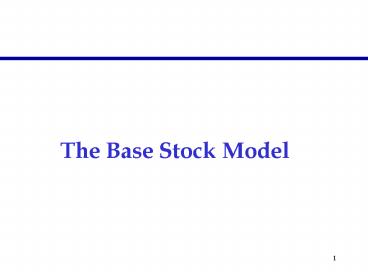The Base Stock Model PowerPoint PPT Presentation
1 / 20
Title: The Base Stock Model
1
The Base Stock Model
2
Assumptions
- Demand occurs continuously over time
- Times between consecutive orders are stochastic
but independent and identically distributed
(i.i.d.) - Inventory is reviewed continuously
- Supply leadtime is a fixed constant L
- There is no fixed cost associated with placing an
order - Orders that cannot be fulfilled immediately from
on-hand inventory are backordered
3
The Base-Stock Policy
- Start with an initial amount of inventory R. Each
time a new demand arrives, place a replenishment
order with the supplier. - An order placed with the supplier is delivered L
units of time after it is placed. - Because demand is stochastic, we can have
multiple orders (inventory on-order) that have
been placed but not delivered yet.
4
The Base-Stock Policy
- The amount of demand that arrives during the
replenishment leadtime L is called the leadtime
demand. - Under a base-stock policy, leadtime demand and
inventory on order are the same. - When leadtime demand (inventory on-order) exceeds
R, we have backorders.
5
Notation
- I inventory level, a random variable
- B number of backorders, a random variable
- X Leadtime demand (inventory on-order), a random
variable - IP inventory position
- EI Expected inventory level
- EB Expected backorder level
- EX Expected leadtime demand
- ED average demand per unit time (demand rate)
6
Inventory Balance Equation
- Inventory position on-hand inventory
inventory on-order backorder level
7
Inventory Balance Equation
- Inventory position on-hand inventory
inventory on-order backorder level - Under a base-stock policy with base-stock level
R, inventory position is always kept at R
(Inventory position R ) - IP IX - B R
- EI EX EB R
8
Leadtime Demand
- Under a base-stock policy, the leadtime demand X
is independent of R and depends only on L and D
with EX EDL (the textbook refers to this
quantity as q). - The distribution of X depends on the distribution
of D.
9
- I max0, I B I B
- Bmax0, B-I B - I
- Since R I X B, we also have
- I B R X
- I R X
- B X R
10
- EI R EX EB R EX E(X R)
- EB EI EX R E(R X) EX R
- Pr(stocking out) Pr(X ? R)
- Pr(not stocking out) Pr(X ? R-1)
- Fill rate E(D) Pr(X ? R-1)/E(D) Pr(X ? R-1)
11
Objective
- Choose a value for R that minimizes the sum of
expected inventory holding cost and expected
backorder cost, Y(R) hEI bEB, where h is
the unit holding cost per unit time and b is the
backorder cost per unit per unit time.
12
The Cost Function
13
The Optimal Base-Stock Level
The optimal value of R is the smallest integer
that satisfies
14
(No Transcript)
15
Choosing the smallest integer R that satisfies
Y(R1) Y(R) ? 0 is equivalent to choosing the
smallest integer R that satisfies
16
Example 1
- Demand arrives one unit at a time according to a
Poisson process with mean l. If D(t) denotes the
amount of demand that arrives in the interval of
time of length t, then - Leadtime demand, X, can be shown in this case to
also have the Poisson distribution with
17
The Normal Approximation
- If X can be approximated by a normal
distribution, then - In the case where X has the Poisson distribution
with mean lL
18
Example 2
If X has the geometric distribution with
parameter r , 0 ? r ? 1
19
Example 2 (Continued)
The optimal base-stock level is the smallest
integer R that satisfies
20
Computing Expected Backorders
- It is sometimes easier to first compute (for a
given R), - and then obtain EBEI EX R.
- For the case where leadtime demand has the
Poisson distribution (with mean q E(D)L), the
following relationship (for a fixed R) applies - EB qPr(XR)(q-R)1-Pr(X? R)

